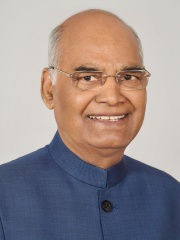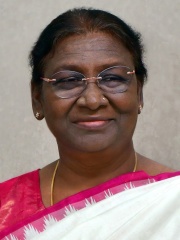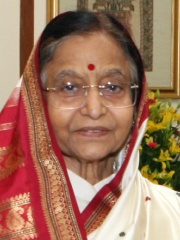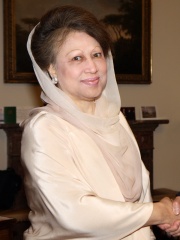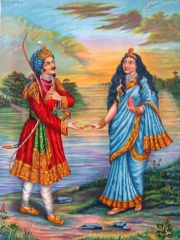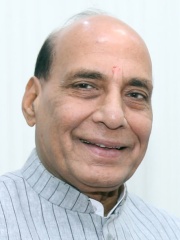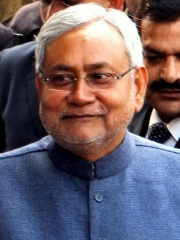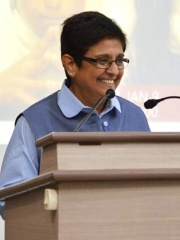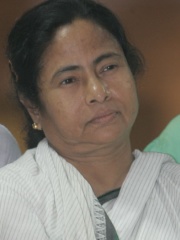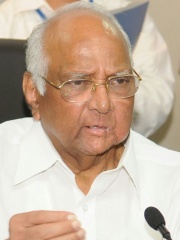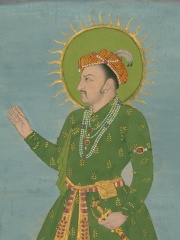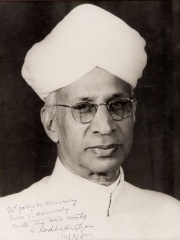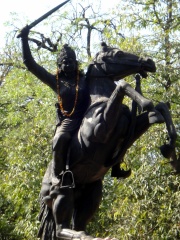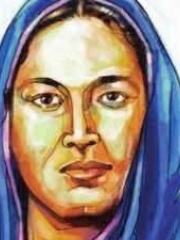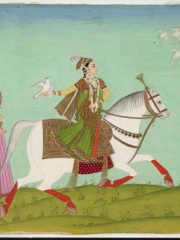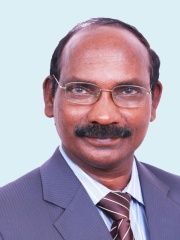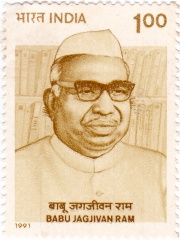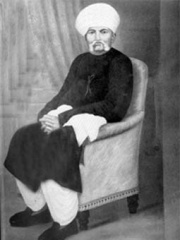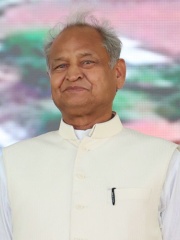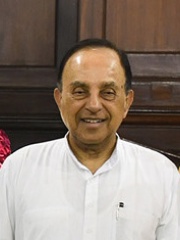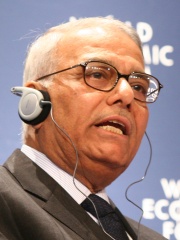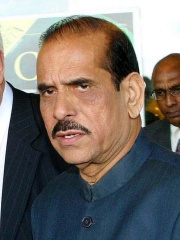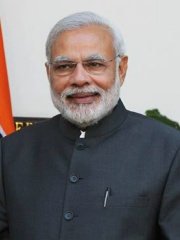


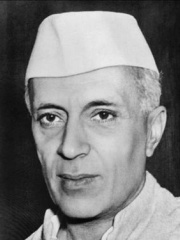
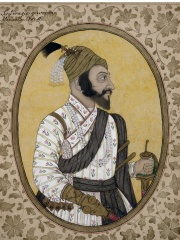
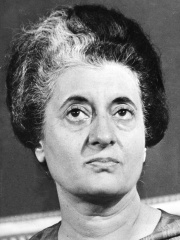
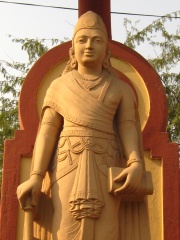
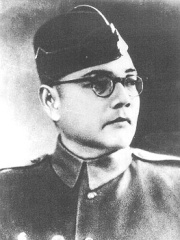
The Most Famous
POLITICIANS from India
This page contains a list of the greatest Indian Politicians. The pantheon dataset contains 19,576 Politicians, 275 of which were born in India. This makes India the birth place of the 12th most number of Politicians behind Japan, and Greece.
Top 10
The following people are considered by Pantheon to be the top 10 most legendary Indian Politicians of all time. This list of famous Indian Politicians is sorted by HPI (Historical Popularity Index), a metric that aggregates information on a biography’s online popularity. Visit the rankings page to view the entire list of Indian Politicians.

1. Narendra Modi (b. 1950)
With an HPI of 82.49, Narendra Modi is the most famous Indian Politician. His biography has been translated into 140 different languages on wikipedia.
Narendra Damodardas Modi (Gujarati: [ˈnəɾendɾə dɑmodəɾˈdɑs ˈmodiː] ; born 17 September 1950) is an Indian politician who has served as the 14th prime minister of India since May 2014. Modi was the chief minister of Gujarat from 2001 to 2014 and is the Member of Parliament (MP) for Varanasi. He is a member of the Bharatiya Janata Party (BJP) and of the Rashtriya Swayamsevak Sangh (RSS), a right wing Hindu nationalist paramilitary volunteer organisation. He is the longest-serving prime minister from outside the Indian National Congress. Modi was born and raised in Vadnagar in northeastern Gujarat, where he completed his secondary education. He was introduced to the RSS at the age of eight. His account of helping his father sell tea at the Vadnagar railway station has not been reliably corroborated. At age 18, he was married to Jashodaben Modi, whom he abandoned soon after, only publicly acknowledging her four decades later when legally required to do so. Modi became a full-time worker for the RSS in Gujarat in 1971. The RSS assigned him to the BJP in 1985 and he held several positions within the party hierarchy until 2001, rising to the rank of general secretary.In 2001, Modi was appointed Chief Minister of Gujarat and elected to the legislative assembly soon after. His administration is considered complicit in the 2002 Gujarat riots, and has been criticised for its management of the crisis. A little over 1,000 people were killed, according to official records, three-quarters of whom were Muslim; independent sources estimated 2,000 deaths, mostly Muslim. A Special Investigation Team appointed by the Supreme Court of India in 2012 found no evidence to initiate prosecution proceedings against him. While his policies as chief minister, which were credited for encouraging economic growth, were praised, Modi's administration was criticised for failing to significantly improve health, poverty and education indices in the state. In the 2014 Indian general election, Modi led the BJP to a parliamentary majority, the first for a party since 1984. His administration increased direct foreign investment, and it reduced spending on healthcare, education, and social-welfare programmes. Modi began a high-profile sanitation campaign, controversially initiated the 2016 demonetisation of high-denomination banknotes and introduced the Goods and Services Tax, and weakened or abolished environmental and labour laws. Modi's administration launched the 2019 Balakot airstrike against an alleged terrorist training camp in Pakistan. The airstrike failed, and the deaths of six Indian personnel to friendly fire was later revealed: but the action had nationalist appeal. Modi's party won the 2019 general election which followed. In its second term, his administration revoked the special status of Jammu and Kashmir, an Indian-administered portion of the disputed Kashmir region, and introduced the Citizenship Amendment Act, prompting widespread protests, and spurring the 2020 Delhi riots in which Muslims were brutalised and killed by Hindu mobs, sometimes with the complicity of police forces controlled by the Modi administration. Three controversial farm laws led to sit-ins by farmers across the country, eventually causing their formal repeal. Modi oversaw India's response to the COVID-19 pandemic, during which 4.7 million out of 1.4 billion Indians died, according to the World Health Organization's estimates.Under Modi's tenure, India has experienced democratic backsliding, or the weakening of democratic institutions, individual rights, and freedom of expression. As prime minister, he has received consistently high approval ratings. Modi has been described as engineering a political realignment towards right-wing politics. He remains a controversial figure domestically and internationally, over his Hindu nationalist beliefs and handling of the Gujarat riots, which have been cited as evidence of a majoritarian and exclusionary social agenda.

2. Ashoka (-304 - -232)
With an HPI of 81.57, Ashoka is the 2nd most famous Indian Politician. His biography has been translated into 152 different languages.
Ashoka (Sanskrit pronunciation: [ɐˈɕoːkɐ], IAST: Aśoka; c. 304 – 232 BCE), popularly known as Ashoka the Great, was the third Mauryan Emperor of Magadha in the Indian subcontinent during c. 268 to 232 BCE. His empire covered the largest part of the Indian subcontinent, stretching from present-day Afghanistan in the west to present-day Bangladesh in the east, with its capital at Pataliputra. A patron of Buddhism, he is credited with playing an important role in the spread of Buddhism across ancient Asia. Ashoka's edicts state that during his eighth regnal year (c. 260 BCE), he conquered Kalinga after a brutal war. Ashoka subsequently devoted himself to the propagation of "dhamma" or righteous conduct, the major theme of the edicts. Ashoka's edicts suggest that a few years after the Kalinga War, he was gradually drawn towards Buddhism. The Buddhist legends credit Ashoka with establishing a large number of stupas, patronising the Third Buddhist council, supporting Buddhist missionaries, making generous donations to the sangha. Ashoka's existence as a historical emperor had almost been forgotten, but since the decipherment in the 19th century of sources written in Brahmi script, Ashoka holds a reputation as one of the greatest Indian emperors. The emblem of the modern Republic of India is an adaptation of the Lion Capital of Ashoka. Ashoka's wheel, the Ashoka Chakra is adopted at the centre of the National Flag of India.

3. A. P. J. Abdul Kalam (1931 - 2015)
With an HPI of 77.96, A. P. J. Abdul Kalam is the 3rd most famous Indian Politician. His biography has been translated into 85 different languages.
Avul Pakir Jainulabdeen Abdul Kalam BR ( ; 15 October 1931 – 27 July 2015) was an Indian aerospace scientist and statesman who served as the 11th president of India from 2002 to 2007. He was born and raised in Rameswaram, Tamil Nadu and studied physics and aerospace engineering. He spent the next four decades as a scientist and science administrator, mainly at the Defence Research and Development Organisation (DRDO) and Indian Space Research Organisation (ISRO) and was intimately involved in India's civilian space programme and military missile development efforts. He thus came to be known as the Missile Man of India for his work on the development of ballistic missile and launch vehicle technology. He also played a pivotal organisational, technical, and political role in India's Pokhran-II nuclear tests in 1998, the first since the original nuclear test by India in 1974.Kalam was elected as the 11th president of India in 2002 with the support of both the ruling Bharatiya Janata Party and the then-opposition Indian National Congress. Widely referred to as the "People's President", he returned to his civilian life of education, writing and public service after a single term. He was a recipient of several prestigious awards, including the Bharat Ratna, India's highest civilian honour. While delivering a lecture at the Indian Institute of Management Shillong, Kalam collapsed and died from an apparent cardiac arrest on 27 July 2015, aged 83. Thousands, including national-level dignitaries, attended the funeral ceremony held in his hometown of Rameswaram, where he was buried with full state honours.

4. Jawaharlal Nehru (1889 - 1964)
With an HPI of 76.79, Jawaharlal Nehru is the 4th most famous Indian Politician. His biography has been translated into 144 different languages.
Jawaharlal Nehru ( NAY-roo or NEH-roo; Hindi: [ˈdʒəʋɑːɦəɾˈlɑːl ˈneːɦɾuː] ; juh-WAH-hurr-LAHL NE-hǝ-ROO; 14 November 1889 – 27 May 1964) was an Indian anti-colonial nationalist, statesman, secular humanist, social democrat, and author who was a central figure in India during the middle of the 20th century. Nehru was a principal leader of the Indian nationalist movement in the 1930s and 1940s. Upon India's independence in 1947, he served as the country's first prime minister for 16 years. Nehru promoted parliamentary democracy, secularism, and science and technology during the 1950s, powerfully influencing India's arc as a modern nation. In international affairs, he steered India clear of the two blocs of the Cold War. A well-regarded author, his books written in prison, such as Letters from a Father to His Daughter (1929), An Autobiography (1936) and The Discovery of India (1946), have been read around the world. The son of Motilal Nehru, a prominent lawyer and Indian nationalist, Jawaharlal Nehru was educated in England—at Harrow School and Trinity College, Cambridge, and trained in the law at the Inner Temple. He became a barrister, returned to India, enrolled at the Allahabad High Court and gradually began to take an interest in national politics, which eventually became a full-time occupation. He joined the Indian National Congress, rose to become the leader of a progressive faction during the 1920s, and eventually of the Congress, receiving the support of Mahatma Gandhi who was to designate Nehru as his political heir. As Congress president in 1929, Nehru called for complete independence from the British Raj. Nehru and the Congress dominated Indian politics during the 1930s. Nehru promoted the idea of the secular nation-state in the 1937 provincial elections, allowing the Congress to sweep the elections, and to form governments in several provinces. In September 1939, the Congress ministries resigned to protest Viceroy Lord Linlithgow's decision to join the war without consulting them. After the All India Congress Committee's Quit India Resolution of 8 August 1942, senior Congress leaders were imprisoned and for a time the organisation was suppressed. Nehru, who had reluctantly heeded Gandhi's call for immediate independence, and had desired instead to support the Allied war effort during World War II, came out of a lengthy prison term to a much altered political landscape. The Muslim League, under Muhammad Ali Jinnah, had come to dominate Muslim politics in the interim. In the 1946 provincial elections, Congress won the elections but the League won all the seats reserved for Muslims, which the British interpreted to be a clear mandate for Pakistan in some form. Nehru became the interim prime minister of India in September 1946, with the League joining his government with some hesitancy in October 1946. Upon India's independence on 15 August 1947, Nehru gave a critically acclaimed speech, "Tryst with Destiny"; he was sworn in as the Dominion of India's prime minister and raised the Indian flag at the Red Fort in Delhi. On 26 January 1950, when India became a republic within the Commonwealth of Nations, Nehru became the Republic of India's first prime minister. He embarked on an ambitious program of economic, social, and political reforms. Nehru promoted a pluralistic multi-party democracy. In foreign affairs, he played a leading role in establishing Non-Aligned Movement, a group of nations that did not seek membership in the two main ideological blocs of the Cold War. Under Nehru's leadership, the Congress emerged as a catch-all party, dominating national and state-level politics and winning elections in 1951, 1957 and 1962. His premiership, spanning 16 years and 286 days—which is, to date, the longest in India—ended with his death in 1964 from a heart attack. Hailed as the "architect of Modern India", his birthday is celebrated as Children's Day in India.
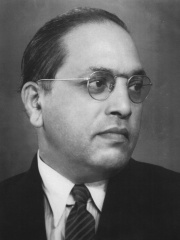
5. B. R. Ambedkar (1891 - 1956)
With an HPI of 76.27, B. R. Ambedkar is the 5th most famous Indian Politician. His biography has been translated into 132 different languages.
Bhimrao Ramji Ambedkar (Bhīmrāo Rāmjī Āmbēḍkar; 14 April 1891 – 6 December 1956) was an Indian jurist, economist, social reformer and political leader who headed the committee drafting the Constitution of India from the Constituent Assembly debates, served as Law and Justice minister in the first cabinet of Jawaharlal Nehru, and inspired the Dalit Buddhist movement after renouncing Hinduism. After graduating from Elphinstone College, University of Bombay, Ambedkar studied economics at Columbia University and the London School of Economics, receiving doctorates in 1927 and 1923, respectively, and was among a handful of Indian students to have done so at either institution in the 1920s. He also trained in the law at Gray's Inn, London. In his early career, he was an economist, professor, and lawyer. His later life was marked by his political activities; he became involved in campaigning and negotiations for partition, publishing journals, advocating political rights and social freedom for Dalits, and contributing to the establishment of the state of India. In 1956, he converted to Buddhism, initiating mass conversions of Dalits.In 1990, the Bharat Ratna, India's highest civilian award, was posthumously conferred on Ambedkar. The salutation Jai Bhim (lit. "Hail Bhim") used by followers honours him. He is also referred to by the nickname Babasaheb (BAH-bə SAH-hayb), meaning "Respected Father".

6. Shivaji (1627 - 1680)
With an HPI of 75.62, Shivaji is the 6th most famous Indian Politician. His biography has been translated into 62 different languages.
Shivaji I (Shivaji Shahaji Bhonsale; Marathi pronunciation: [ʃiʋaːd͡ʒiˑ bʱoˑs(ə)leˑ]; c. 19 February 1630 – 3 April 1680) was an Indian ruler and a member of the Bhonsle Maratha clan. Shivaji carved out his own independent kingdom from the declining Adilshahi Sultanate of Bijapur that formed the genesis of the Maratha Empire. In 1674, he was formally crowned the Chhatrapati of his realm at Raigad Fort.Over the course of his life, Shivaji engaged in both alliances and hostilities with the Mughal Empire, the Sultanate of Golkonda, the Sultanate of Bijapur and the European colonial powers. Shivaji's military forces expanded the Maratha sphere of influence, capturing and building forts, and forming a Maratha navy. Shivaji established a competent and progressive civil administration with well-structured administrative institutions. He revived ancient Hindu political traditions, court conventions and promoted the use of the Marathi and Sanskrit languages, replacing Persian at court and in administration. Praised for his chivalrous treatment of women, Shivaji employed people of all castes and religions, including Muslims and Europeans, in his administration and armed forces.Shivaji's legacy was to vary by observer and time, but nearly two centuries after his death he began to take on increased importance with the emergence of the Indian independence movement, as many Indian nationalists elevated him as a proto-nationalist and hero of the Hindus.

7. Indira Gandhi (1917 - 1984)
With an HPI of 75.04, Indira Gandhi is the 7th most famous Indian Politician. Her biography has been translated into 128 different languages.
Indira Feroze Gandhi (Hindi: [ˈɪndɪɾɑː ˈɡɑːndʱi] ; née Nehru; 19 November 1917 – 31 October 1984) was an Indian politician who served as the third Prime Minister of India from 1966 to 1977 and again from 1980 until her assassination in 1984. She was India's first and, to date, only female prime minister, and a central figure in Indian politics as the leader of the Indian National Congress. Gandhi was the daughter of Jawaharlal Nehru, the first prime minister of India, and the mother of Rajiv Gandhi, who succeeded her in office as the country's sixth prime minister. Furthermore, Gandhi's cumulative tenure of 15 years and 350 days makes her the second-longest-serving Indian prime minister after her father. Henry Kissinger described her as an "Iron Lady", a nickname that became associated with her tough personality since her lifetime.During Nehru's premiership from 1947 to 1964, Gandhi served as his hostess and accompanied him on his numerous foreign trips. In 1959, she played a part in the dissolution of the communist-led Kerala state government as then-president of the Indian National Congress, otherwise a ceremonial position to which she was elected earlier that year. Lal Bahadur Shastri, who had succeeded Nehru as prime minister upon his death in 1964, appointed her minister of information and broadcasting in his government; the same year she was elected to the Rajya Sabha, the upper house of the Indian Parliament. On Shastri's sudden death in January 1966, Gandhi defeated her rival, Morarji Desai, in the Congress Party's parliamentary leadership election to become leader and also succeeded Shastri as prime minister. She led the Congress to victory in two subsequent elections, starting with the 1967 general election, in which she was first elected to the lower house of the Indian parliament, the Lok Sabha. In 1971, the Congress Party headed by Gandhi managed to secure its first landslide victory since her father's sweep in 1962, focusing on issues such as poverty. But following the nationwide Emergency implemented by her, she faced massive anti-incumbency and lost the 1977 general election, the first time for the Congress party to do so. Gandhi was ousted from office and even lost her seat in parliament in the election. Nevertheless, her faction of the Congress Party won the next general election by a landslide, due to Gandhi's leadership and weak governance of the Janata Party rule, the first non-Congress government in independent modern India's history. As prime minister, Gandhi was known for her political intransigence and unprecedented centralization of power. In 1967, she headed a military conflict with China in which India successfully repelled Chinese incursions in the Himalayas. In 1971, she went to war with Pakistan in support of the independence movement and war of independence in East Pakistan, which resulted in an Indian victory and the creation of Bangladesh, as well as increasing India's influence to the point where it became the sole regional power in South Asia. Gandhi's rule saw India grow closer to the Soviet Union by signing a friendship treaty in 1971, with India receiving military, financial, and diplomatic support from the Soviet Union during its conflict with Pakistan in the same year. Despite India being at the forefront of the non-aligned movement, Gandhi led India to become one of the Soviet Union's closest allies in Asia, with India and the Soviet Union often supporting each other in proxy wars and at the United Nations. Citing separatist tendencies and in response to a call for revolution, Gandhi instituted a state of emergency from 1975 to 1977, during which basic civil liberties were suspended and the press was censored. Widespread atrocities were carried out during that period. Gandhi faced the growing Sikh separatism throughout her third premiership; in response, she ordered Operation Blue Star, which involved military action in the Golden Temple and resulted in bloodshed with hundreds of Sikhs killed. On 31 October 1984, Gandhi was assassinated by her bodyguards, both of whom were Sikh nationalists seeking retribution for the events at the temple. Gandhi is remembered as the most powerful woman in the world during her tenure. Her supporters cite her leadership during victories over geopolitical rivals China and Pakistan, the Green Revolution, a growing economy in the early 1980s, and her anti-poverty campaign that led her to be known as "Mother Indira" (a pun on Mother India) among the country's poor and rural classes. However, critics note her authoritarian rule of India during the Emergency. In 1999, Gandhi was named "Woman of the Millennium" in an online poll organized by the BBC. In 2020, Gandhi was named by Time magazine among the 100 women who defined the past century as counterparts to the magazine's previous choices for Man of the Year.

8. Chandragupta Maurya (-340 - -297)
With an HPI of 72.52, Chandragupta Maurya is the 8th most famous Indian Politician. His biography has been translated into 81 different languages.
Chandragupta Maurya (350–295 BCE) was the founder of the Maurya Empire, a geographically-extensive empire based in Magadha. He reigned from 320 BCE to 298 BCE. The Magadha kingdom expanded to become an empire that reached its peak under the reign of his grandson, Ashoka the Great, from 268 BCE to 231 BCE. The nature of the political formation that existed in Chandragupta's time is not certain. The Mauryan empire was a loose-knit one with large autonomous regions within its limits.Prior to his consolidation of power, Alexander the Great had invaded the North-West Indian subcontinent before abandoning his campaign in 324 BCE due to a mutiny caused by the prospect of facing another large empire, presumably the Nanda Empire. Chandragupta defeated and conquered both the Nanda Empire centered in Pataliputra, Magadha and the Greek satraps that were appointed or formed from Alexander's Empire in South Asia. Afterwards, Chandragupta expanded and secured his western border, where he was confronted by Seleucus I Nicator in the Seleucid–Mauryan war. After two years of war, Chandragupta was considered to have gained the upper hand in the conflict and annexed satrapies up to the Hindu Kush. Instead of prolonging the war, both parties settled on a marriage treaty. Chandragupta's empire extended throughout most of South Asia, spanning from modern day Bengal to Afghanistan across North India as well as making inroads into Central and South India. In contrast to the Jain legends which developed 900 years later, contemporary Greek evidence states that Chandragupta did not give up performing the rites of sacrificing animals associated with Vedic Brahminism; he delighted in hunting and otherwise leading a life remote from the Jain practice of Ahimsa or nonviolence towards living beings. Chandragupta's reign, and the Maurya Empire, set an era of economic prosperity, reforms, infrastructure expansions, and tolerance. Many religions thrived within his realms and his descendants' empire. Buddhism, Jainism and Ājīvika gained prominence alongside Vedic and Brahmanistic traditions, and minority religions such as Zoroastrianism and the Greek pantheon were respected. A memorial for Chandragupta Maurya exists on the Chandragiri hill along with a seventh-century hagiographic inscription.

9. Subhas Chandra Bose (1897 - 1945)
With an HPI of 71.45, Subhas Chandra Bose is the 9th most famous Indian Politician. His biography has been translated into 65 different languages.
Subhas Chandra Bose ( shuub-HAHSS CHUN-drə BOHSS; 23 January 1897 – 18 August 1945) was an Indian nationalist whose defiance of British authority in India made him a hero among many Indians, but his wartime alliances with Nazi Germany and Imperial Japan left a legacy vexed by authoritarianism, anti-Semitism, and military failure. The honorific 'Netaji' (Bengali: "Respected Leader") was first applied to Bose in Germany in early 1942—by the Indian soldiers of the Indische Legion and by the German and Indian officials in the Special Bureau for India in Berlin. It is now used throughout India.Bose was born into wealth and privilege in a large Bengali family in Orissa during the British Raj. The early recipient of an Anglo-centric education, after college he was sent to England to take the Indian Civil Service examination. He succeeded with distinction in the first exam but demurred at taking the routine final exam, citing nationalism as a higher calling. Returning to India in 1921, Bose joined the nationalist movement led by Mahatma Gandhi and the Indian National Congress. He followed Jawaharlal Nehru to leadership in a group within the Congress which was less keen on constitutional reform and more open to socialism. Bose became Congress president in 1938. After reelection in 1939, differences arose between him and the Congress leaders, including Gandhi, over the future federation of British India and princely states, but also because discomfort had grown among the Congress leadership over Bose's negotiable attitude to non-violence, and his plans for greater powers for himself. After the large majority of the Congress Working Committee members resigned in protest, Bose resigned as president and was eventually ousted from the party.In April 1941 Bose arrived in Nazi Germany, where the leadership offered unexpected but equivocal sympathy for India's independence. German funds were employed to open a Free India Centre in Berlin. A 3,000-strong Free India Legion was recruited from among Indian POWs captured by Erwin Rommel's Afrika Korps to serve under Bose. Although peripheral to their main goals, the Germans inconclusively considered a land invasion of India throughout 1941. By the spring of 1942, the German army was mired in Russia and Bose became keen to move to southeast Asia, where Japan had just won quick victories. Adolf Hitler during his only meeting with Bose in late May 1942 agreed to arrange a submarine. During this time, Bose became a father; his wife, or companion, Emilie Schenkl, gave birth to a baby girl. Identifying strongly with the Axis powers, Bose boarded a German submarine in February 1943. Off Madagascar, he was transferred to a Japanese submarine from which he disembarked in Japanese-held Sumatra in May 1943.With Japanese support, Bose revamped the Indian National Army (INA), which comprised Indian prisoners of war of the British Indian army who had been captured by the Japanese in the Battle of Singapore. A Provisional Government of Free India was declared on the Japanese-occupied Andaman and Nicobar Islands and was nominally presided by Bose. Although Bose was unusually driven and charismatic, the Japanese considered him to be militarily unskilled, and his soldierly effort was short-lived. In late 1944 and early 1945, the British Indian Army reversed the Japanese attack on India. Almost half of the Japanese forces and fully half of the participating INA contingent were killed. The remaining INA was driven down the Malay Peninsula and surrendered with the recapture of Singapore. Bose chose to escape to Manchuria to seek a future in the Soviet Union which he believed to have turned anti-British. Bose died from third-degree burns after his plane crashed in Japanese Taiwan on August 18, 1945. Some Indians did not believe that the crash had occurred, expecting Bose to return to secure India's independence. The Indian National Congress, the main instrument of Indian nationalism, praised Bose's patriotism but distanced itself from his tactics and ideology. The British Raj, never seriously threatened by the INA, charged 300 INA officers with treason in the Indian National Army trials, but eventually backtracked in the face of opposition by the Congress, and a new mood in Britain for rapid decolonisation in India.Bose's legacy is mixed. Among many in India, he is seen as a hero, his saga serving as a would-be counterpoise to the many actions of regeneration, negotiation, and reconciliation over a quarter-century through which the independence of India was achieved. His collaborations with Japanese Fascism and Nazism pose serious ethical dilemmas, especially his reluctance to publicly criticize the worst excesses of German anti-Semitism from 1938 onwards or to offer refuge in India to its victims.
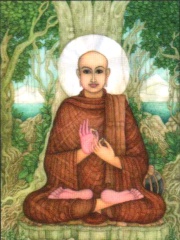
10. Sariputta (-568 - -484)
With an HPI of 71.06, Sariputta is the 10th most famous Indian Politician. His biography has been translated into 44 different languages.
Śāriputra (Sanskrit: शारिपुत्र; Tibetan: ཤཱ་རིའི་བུ་, Pali: Sāriputta, lit. "the son of Śāri", born Upatiṣya, Pali: Upatissa) was one of the top disciples of the Buddha. He is considered the first of the Buddha's two chief male disciples, together with Maudgalyāyana (Pali: Moggallāna). Śāriputra had a key leadership role in the ministry of the Buddha and is considered in many Buddhist schools to have been important in the development of the Buddhist Abhidharma. He frequently appears in Mahayana sutras, and in some sutras, is used as a counterpoint to represent the Hinayana school of Buddhism. Historians believe Śāriputra was born in the ancient Indian kingdom of Magadha around the 6th or 5th century BCE. Buddhist texts relate that Śāriputra and Maudgalyāyana were childhood friends who became spiritual wanderers in their youth. After having searched for spiritual truth with other contemporary teachers, they came into contact with the teachings of the Buddha and ordained as monks under him, after which the Buddha declared the friends his two chief disciples. Śāriputra was said to have attained enlightenment as an arhat two weeks after ordination. As chief disciple Śāriputra assumed a leadership role in the Sangha, doing tasks like looking after monks, assigning them objects of meditation, and clarifying points of doctrine. He was the first disciple the Buddha allowed to ordain other monks. Śāriputra died shortly before the Buddha in his hometown and was cremated. According to Buddhist texts, his relics were then enshrined at Jetavana Monastery. Archaeological findings from the 1800s suggest his relics may have been redistributed across the Indian subcontinent by subsequent kings. Śāriputra is regarded as an important and wise disciple of the Buddha, particularly in Theravada Buddhism where he is given a status close to a second Buddha. In Buddhist art, he is often depicted alongside the Buddha, usually to his right. Śāriputra was known for his strict adherence to the Buddhist monastic rules, as well as for his wisdom and teaching ability, giving him the title "General of the Dharma" (Sanskrit: Dharmasenāpati; Pali: Dhammasenāpati). Śāriputra is considered the disciple of the Buddha who was foremost in wisdom. His female counterpart was Kṣemā (Pali: Khemā).
People
Pantheon has 321 people classified as Indian politicians born between 2000 BC and 1998. Of these 321, 101 (31.46%) of them are still alive today. The most famous living Indian politicians include Narendra Modi, Ram Nath Kovind, and Droupadi Murmu. The most famous deceased Indian politicians include Ashoka, A. P. J. Abdul Kalam, and Jawaharlal Nehru. As of April 2024, 37 new Indian politicians have been added to Pantheon including Droupadi Murmu, Faisal bin Turki, Sultan of Muscat and Oman, and Jhalkaribai.
Living Indian Politicians
Go to all RankingsNarendra Modi
1950 - Present
HPI: 82.49
Ram Nath Kovind
1945 - Present
HPI: 63.82
Droupadi Murmu
1958 - Present
HPI: 61.99
Pratibha Patil
1934 - Present
HPI: 60.29
Khaleda Zia
1945 - Present
HPI: 59.18
Shantanu
HPI: 56.52
Rajnath Singh
1951 - Present
HPI: 54.26
Lalu Prasad Yadav
1948 - Present
HPI: 54.03
Nitish Kumar
1951 - Present
HPI: 52.89
Kiran Bedi
1949 - Present
HPI: 52.32
Mamata Banerjee
1955 - Present
HPI: 50.47
Sharad Pawar
1940 - Present
HPI: 50.45
Deceased Indian Politicians
Go to all RankingsAshoka
304 BC - 232 BC
HPI: 81.57
A. P. J. Abdul Kalam
1931 - 2015
HPI: 77.96
Jawaharlal Nehru
1889 - 1964
HPI: 76.79
B. R. Ambedkar
1891 - 1956
HPI: 76.27
Shivaji
1627 - 1680
HPI: 75.62
Indira Gandhi
1917 - 1984
HPI: 75.04
Chandragupta Maurya
340 BC - 297 BC
HPI: 72.52
Subhas Chandra Bose
1897 - 1945
HPI: 71.45
Sariputta
568 BC - 484 BC
HPI: 71.06
Jahangir
1569 - 1627
HPI: 70.84
Aurangzeb
1618 - 1707
HPI: 70.71
Sarvepalli Radhakrishnan
1888 - 1975
HPI: 70.68
Newly Added Indian Politicians (2024)
Go to all RankingsDroupadi Murmu
1958 - Present
HPI: 61.99
Faisal bin Turki, Sultan of Muscat and Oman
1864 - 1913
HPI: 53.62
Jhalkaribai
1830 - 1858
HPI: 51.45
Fatima Sheikh
1831 - 1900
HPI: 51.26
Chand Bibi
1550 - 1599
HPI: 51.20
K. Sivan
1957 - Present
HPI: 50.03
Jagjivan Ram
1908 - 1986
HPI: 49.43
Karamchand Gandhi
1822 - 1885
HPI: 47.88
Ashok Gehlot
1951 - Present
HPI: 47.30
Subramanian Swamy
1939 - Present
HPI: 44.95
Yashwant Sinha
1937 - Present
HPI: 44.38
Manohar Joshi
1937 - 2024
HPI: 44.36
Overlapping Lives
Which Politicians were alive at the same time? This visualization shows the lifespans of the 25 most globally memorable Politicians since 1700.

